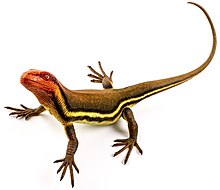Hylonomus
| Hylonomus Temporal range: Pennsylvanian,
| |
|---|---|

| |
| Life restoration | |
| Scientific classification | |
| Domain: | Eukaryota |
| Kingdom: | Animalia |
| Phylum: | Chordata |
| Class: | Reptilia |
| Clade: | Eureptilia |
| Genus: | †Hylonomus Dawson, 1860 |
| Type species | |
| †Hylonomus lyelli Dawson, 1860
| |
Hylonomus (/haɪˈlɒnəməs/; hylo- "forest" + nomos "dweller")[1] is an extinct genus of reptile that lived 312 million years ago during the Late Carboniferous period.[2] It is the earliest unquestionable reptile (Westlothiana is older, but in fact it may have been an amphibian, and Casineria is rather fragmentary). The only species is the type species Hylonomous lyelli.
Description


Hylonomus was 20–25 centimetres (8–10 in) long (including the tail). Most of them are 20 cm long and probably would have looked rather similar to modern lizards. It had small sharp teeth and it likely ate small invertebrates such as millipedes or early insects.[3]
Fossils of Hylonomus have been found in the remains of fossilized club moss stumps in the Joggins Formation, Joggins, Nova Scotia, Canada. It is supposed that, after harsh weather, the club mosses would crash down, with the stumps eventually rotting and hollowing out. Small animals such as Hylonomus, seeking shelter, would enter and become trapped, starving to death. An alternative hypothesis is that the animals made their nests in the hollow tree stumps.[4]
Fossils of the basal pelycosaur Archaeothyris and the basal diapsid Petrolacosaurus are also found in the same region of Nova Scotia, although from a higher stratum, dated approximately 6 million years later.[2]
Fossilized footprints found in New Brunswick have been attributed to Hylonomus, at an estimated age of 315 million years.[5]
This animal was discovered by John William Dawson in the mid-19th century.[6] The species' name was given it by Dawson's teacher, the geologist Sir Charles Lyell. While it has traditionally been included in the group Protothyrididae, later studies have shown that it is probably more closely related to diapsids.[7]
Hylonomus lyelli was named the Provincial Fossil of Nova Scotia in 2002.
References
- ^ Genus Hylonomus Etymology
- ^ a b van Tuinen, Marcel; Elizabeth A. Hadly (2004). "Error in Estimation of Rate and Time Inferred from the Early Amniote Fossil Record and Avian Molecular Clocks" (PDF). Journal of Molecular Evolution. 59 (2): 267–276. doi:10.1007/s00239-004-2624-9. PMID 15486700. Archived from the original (PDF) on June 28, 2011. Retrieved 2009-09-02.
{{cite journal}}: Unknown parameter|deadurl=ignored (|url-status=suggested) (help) - ^ Palmer, D., ed. (1999). The Marshall Illustrated Encyclopedia of Dinosaurs and Prehistoric Animals. London: Marshall Editions. p. 62. ISBN 1-84028-152-9.
- ^ McGhee, George R. Jr. (12 November 2013). When the Invasion of Land Failed: The Legacy of the Devonian Extinctions. Columbia University Press. pp. 254–5. ISBN 978-0-231-16057-5. Retrieved 10 June 2015.
- ^ Falcon-Lang, H.J., Benton, M.J. & Stimson, M. (2007): Ecology of early reptiles inferred from Lower Pennsylvanian trackways. Journal of the Geological Society, London, 164; no. 6; pp 1113-1118. article
- ^ J. W. Dawson. 1860. On a Terrestrial Mollusk, a Chilognathous Myriapod, and some New Species of Reptiles, from the Coal-Formation of Nova Scotia. Quarterly Journal of the Geological Society of London 16:268-277
- ^ Muller, J.; Reisz, R.R. (2006). "The phylogeny of early eureptiles: Comparing parsimony and Bayesian approaches in the investigation of a basal fossil clade". Systematic Biology. 55 (3): 503–511. doi:10.1080/10635150600755396. PMID 16861212.
External links
- Fossils of Nova Scotia - The Tree Stump Animals
- Transitional Vertebrate Fossils FAQ Part 1B
- Early Researchers & Finds of the Joggins Fossil Cliffs
- The Science of the Joggins Fossil Cliffs
- Hylonomus: Provincial Fossil of Nova Scotia
